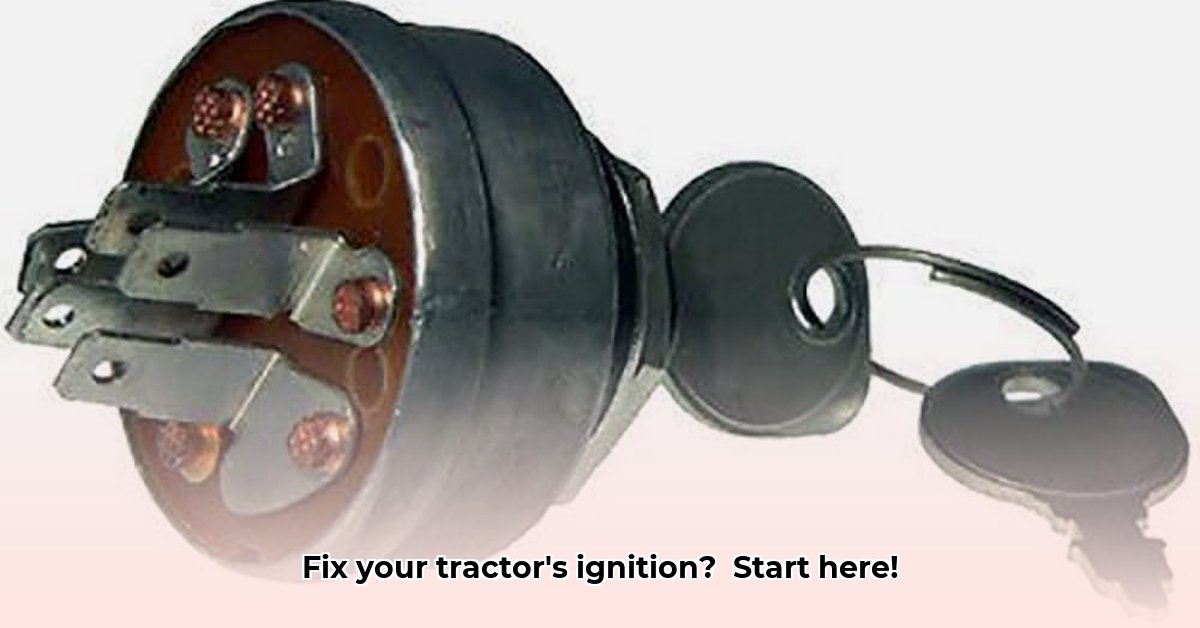
Recognizing Trouble: When Your Ignition Switch Needs Attention
A reliable ignition switch is the unsung hero of farm efficiency. Imagine this: you're in the midst of harvest, the sun is setting, and your tractor refuses to start. The consequences—lost time, potential crop damage, and mounting stress—are significant. Don't let a faulty ignition switch derail your operations. Several key signs indicate trouble:
- Intermittent Starting Issues: Does your tractor sputter and hesitate before starting, or sometimes fail to start altogether? This points to a problem with the electrical connection or the switch itself.
- Loose or Unresponsive Key: A key that feels loose, jiggles excessively, or doesn't turn smoothly in the ignition barrel is a telltale sign of wear.
- Electrical Glitches: Are your tractor's lights flickering, instruments malfunctioning, or other electrical systems behaving erratically? These problems often stem from a faulty ignition switch.
- Complete Engine Failure: If your tractor won't start at all, a faulty ignition switch is a high-probability cause. Don't delay; a quick resolution saves time and money.
Ignoring these warning signs will cost you money and time and could potentially create significant safety hazards. Proactive maintenance is key to uninterrupted productivity. For more information on diagnosing ignition switch issues, check out this helpful resource: John Deere Lawn Tractor.
Choosing the Right Replacement: Finding the Perfect Fit
Selecting the correct replacement ignition switch is a simple process, but critical factors will ensure you maximize its lifespan and protect your investment. Here's a breakdown:
- Brand Reputation: Established brands (like those available at Tractor Supply) often offer superior quality and longer warranties, signifying higher reliability.
- Warranty: A longer warranty period demonstrates the manufacturer's confidence in the switch's durability. A 2-3 year warranty is typical for higher-quality options.
- Material Composition: Durable materials like high-grade metal alloys will resist wear and tear longer than cheaper plastic alternatives.
- Sustainability: Consider the environmental impact. Many manufacturers now prioritize recycled or sustainable materials in their production, aligning with environmentally conscious farming practices.
Example Comparison Chart (prices will vary; consult Tractor Supply for current offerings):
| Brand | Approximate Price Range | Warranty Length | Material Composition | Estimated Lifespan | Sustainability Notes |
|---|---|---|---|---|---|
| Economy Choice | $15-$30 | 1 year | Primarily Plastic | 2-3 years | Potentially uses some recycled materials. |
| Mid-Range Option | $30-$50 | 2 years | Metal and plastic combination | 3-5 years | May utilize some recycled materials. |
| Premium Choice | $50-$75 | 3 years | High-Grade Metal Alloys | 5+ years | Often made with recycled or sustainable metals. |
Remember, an investment in a high-quality switch means fewer replacements and less downtime in the long run. Is that extra upfront cost truly worth it? The answer is a resounding yes when you consider the value of your time and the cost of your operation.
Step-by-Step Installation: A Safe and Efficient Process
Before beginning this process, always disconnect your tractor's negative battery terminal. This critical safety step prevents accidental electrical shocks and potential damage.
- Preparation: Gather your tools: screwdrivers (Phillips and flathead), possibly a socket wrench, and a clean workspace. Having clear photos or a video of the old switch's wiring before removal is invaluable.
- Removal: Carefully remove the old ignition switch, taking photos or making notes to document the wiring connections.
- Installation: Insert the new switch, aligning it with the mounting points. Securely fasten it with the appropriate screws.
- Wiring: Reconnect the wires precisely as they were on the old switch, ensuring a firm connection for each wire.
- Testing: Reconnect the battery's negative terminal. Turn the key to the "on" position; the instrument panel should illuminate. Attempt to start the engine.
A minor investment of your time, combined with a few simple tools, can return your tractor to peak operating condition. This investment prevents unexpected downtime and boosts productivity.
Maintenance and Prevention: Extending the Lifespan of Your Ignition Switch
Preventative maintenance is critical in extending the life of your ignition switch.
- Regular Inspections: Visually inspect the switch for any signs of corrosion, damage, or loose connections.
- Cleaning: Keep the ignition switch area free of debris, dirt, and moisture; this prevents corrosion.
- Lubrication: A small amount of dielectric grease on the electrical connectors can prevent corrosion and ensure a smooth key operation.
- Environmental Protection: Shield the switch from excessive moisture or extreme temperatures.
These simple steps can drastically increase the operational lifespan while reducing long-term costs. Isn't that an investment worth making?
Sustainability: Environmentally Conscious Farming Practices
Even seemingly small components like ignition switches have environmental footprints.
- Eco-Friendly Materials: Choose switches made from recycled or readily recyclable materials.
- Manufacturing Processes: Select manufacturers committed to sustainable manufacturing practices.
- Responsible Disposal: Properly recycle or dispose of old ignition switches, following your local regulations.
These seemingly small decisions ripple outwards, supporting environmental sustainability within your wider farming operations.
The Bottom Line: Maximize Efficiency, Minimize Environmental Impact
Investing in a high-quality ignition switch from Tractor Supply minimizes costly downtime and supports sustainable farming practices. The upfront cost is far outweighed by increased productivity, reduced repair expenses, and environmental responsibility. A small investment today ensures a more efficient and sustainable farm for years to come.